Abstract
The ecological livability of a city reflects the overall civilization degree and sustainable development ability of this region. The establishment of a scientific and reasonable evaluation index system for eco-livable cities helps analyze the level of sustainable development of cities and the quality of life of residents, thus promoting high-quality development of cities. However, few scholars construct a universal evaluation index system for eco-livable cities from synergistic perspective. This paper establishes a multidimensional evaluation index system based on the Theory of Synergism of Five Laws (considering five aspects of economy, society, technology, environment and nature) and analyzes the trends of the evaluation value and coupling coordination degree of five systems in Beijing from 2010 to 2021 by using the systematic methods of a five-law analysis and a five-law synergy integration included in the Theory of Synergism of Five Laws, respectively. The results show that the ecological livability of Beijing generally maintains an upward trend and reaches a well-coordinated level in 2021, but the development level of each system is constrained by different factors. Based on the above results, this paper proposes policy recommendations to improve the ecological livability of cities in combination with the comprehensive model of policy-oriented coupling of multiple subjects to promote the coupling of five systems, with a view to providing references for decision-making in building an eco-livable city.
1. Introduction
Urbanization began with the industrial revolution in the mid-18th century. The transformation of the mode of production drove human society from agricultural to industrial civilization and from rural to urban society [1]. From the development models of urbanization around the world, Britain was driven by industrialization; the United States adopted the urbanization development model from centralization to decentralization to intensification; Germany adopted the urbanization development model of coordinated development of large, medium, and small cities; Japan and South Korea were government-led rapid urbanization development models; and Latin American countries adopted the development model of excessive urbanization beyond the stage of economic development [2]. China has explored a unique urbanization development path with Chinese characteristics in hot issues such as urban scale orientation, urban-rural relationship orientation, urban population control, and urban environmental policies [3]. The purpose of urbanization is to make urban development serve the national economic construction and lay the material foundation for social development. However, in the process of urban development, human beings have neglected the balance between economic development and environmental protection, which has led to a series of “urban diseases,” such as traffic congestion, housing tension, environmental pollution, and unbalanced regional development, and the ecological environment of cities has been seriously damaged.
In order to address these urban crises and achieve sustainable development of human settlements, a variety of ideas for urban development models have been proposed, from the ideal state, utopia, and solar city envisioned by the pioneers of humanism to the later idyllic city, satellite city, landscape city, and low-carbon city [4]. Although people have not yet been completely consistent in their urban visions, these visions have stimulated the emergence of a new urban development concept, namely the eco-livable city. The goal of these eco-livable cities is to create a harmonious and progressive society with a good ecological environment and sustainable economic development by applying the principles of ecological economics and system engineering methods within the carrying capacity of the ecosystem [5]. Urban development includes not only the increase of quantity and expansion of scale but also the comprehensive improvement and overall coordination of urban spatial structure and function.
According to existing literature, domestic and foreign scholars’ research on urban ecological livability mainly focuses on four aspects: definitions, evaluation index systems, evaluation methods and development strategies. In terms of the definition of eco-livable cities, most scholars define eco-livable cities based on the concept of people-centeredness, believing that eco-livable cities should provide a suitable living environment for residents while meeting the requirements of sustainable development of the ecological environment [6]. Although the livability of a city is determined by objective conditions (e.g., employment rate, green space per capita, public services), it also includes residents’ perceptions of social well-being and economic development [7], i.e., urban residents’ satisfaction is an important measure of the level of development of an ecologically livable city [8], and the two show a positive correlation [9]. Although scholars have not yet formed a unified definition of the concept of the eco-livable city, after analysis, it is found that scholars have the same understanding of the connotation of the eco-livable city, and the common elements of ecological city can be summarized as (1) Eco-livable cities can provide residents with a good ecological environment and sufficient living space; (2) Eco-livable cities are sustainable cities whose construction scale and population density, etc. cannot exceed the environmental carrying capacity; (3) Eco-livable city is a coordinated city, reflected externally in the coordination between the city and its surroundings, and internally in the coordination between economic development and the ecological environment.
In terms of the evaluation index system of eco-livable cities, experts and scholars generally agree that social developments, economic strength and climate conditions are important factors affecting the eco-livability of cities. For example, Pacione established an objective evaluation model of urban ecological livability from the three dimensions of society, population and economy [10]. With further research, some scholars believe that residents’ perception of ecological livability is also an important influencing factor; for example, Benjamin L. Saitluanga constructed a system of indexes to measure urban eco-livability from six dimensions, in which economic, social, family and accessibility are objective indexes, and residents’ satisfaction with economic and social aspects and satisfaction with natural environment and infrastructure development are subjective indexes [11].
In terms of evaluation methods, scholars are committed to finding a more reasonable and scientific evaluation method. The more cutting-edge research methods currently applied in the field of livable city research include remote sensing technology, machine learning methods, non-parametric Kernel density estimation method [12], and GridMet model [13]. Some scholars have used a combination of research methods, such as the combination of hierarchical analysis and cognitive map technology [14], remote sensing technology and TOPSIS [15], and remote sensing technology and machine learning [16], which provide new ideas for building a scientific evaluation system of eco-livable cities. Some scholars explore the development paths of livable cities by studying the factors influencing urban livability; for example, Ghasemi et al. argued that urban elements and their functions influence the ecological livability of cities [17], and Parker and Zingoni de Baro suggested that high-quality public green infrastructure enhances individuals’ perceptions of urban livability [18].
Research on eco-livable cities has been fruitful, and scholars have used various methods to construct an evaluation index system for eco-livable cities. Based on existing studies, scholars mostly evaluate the ecological livability of cities by evaluating their economic, social, and environmental development levels; however, the synergistic relationship among these systems has been neglected. Most of the macroscopic studies on urban development take sustainable development theory [19], ecological civilization theory [20], and system theory [21] as the theoretical basis, but the classification of specific evaluation indexes is mostly based on the subjective judgment of researchers and lacks a clear and specific classification basis.
Based on the above background, we innovatively propose to measure the ecological livability of cities from a synergistic perspective, providing new ideas for building eco-livable cities. The main contributions and research innovation of this study include: (1) Applying the Theory of Synergy of Five Laws to the study of eco-livable cities, which not only considers the impact of the development level of economic, social and environmental systems on the ecological livability of cities, but also takes into account the synergistic relationship between systems, and construct a scientific and applicable evaluation index system of urban ecological livability, which few scholars have constructed from the perspective of synergy in previous studies. (2) We innovatively applied the analysis methods included in the Theory of Synergism of Five Laws to explain the evaluation results of TOPSIS calculation and analyzed in detail the changes in ecological livability of Beijing from 2010 to 2021 and their causes. (3) We embody the concept of synergy in all stages of this study and propose policy recommendations to improve the ecological livability of cities in combination with the comprehensive model of policy-oriented coupling of multiple subjects to promote the coupling of five systems to provide a reference for building eco-livable cities.
2. Theory of Synergism of Five Laws and Its Applicability
The Theory of the Synergism of Five Laws refers to the fact that the level and speed of development of human society are always governed by economic, social, technological, environmental, and natural laws in the process of social development [22]. The synergism of five laws is the basic rule of environmental management and environmental decision-making revealed by environmental science, which provides two methodologies: the five-law analysis and the five-law synergism (the former is a system analysis method. The latter is a system synthesis method) and is applicable to analyze the objective laws of the development of complex systems and to judge the accessibility of goals, feasibility and effectiveness of approaches [23].
2.1. Systematic Method of Five-Law Analysis
The Theory of Synergism of Five Laws reveals that these five laws play a decisive and dominant role in natural, technological, economic, social and environmental phenomena, while people promote the development of natural, technological, economic, social and environmental sciences in the process of understanding and exploring these five types of phenomena and five types of laws [24].
- (1)
- Natural laws: Natural laws are objective laws relative to the natural environment, the essential and inevitable connections shown in the development of various things in nature, and the natural laws followed by the movement and change of things [25]. The laws of nature exist independently of human activities objectively. Humans pursue the synergy between man and nature in the process of understanding and transforming the natural world.
- (2)
- Social laws: Social laws are the inevitable connections between the intrinsic nature of social development and the regular connections formed by human beings interacting with other individuals in their practical activities [26]. Such laws are expressed through conscious behavior with the participation of human beings. The increase in social productivity makes the interaction between man and the natural environment more complex.
- (3)
- Economic laws: Economic laws are general laws formed in the process of human behavior of production, distribution, exchange, consumption, etc. Economic laws are the intrinsic and essential connections and trends in human economic activities that do not depend on people’s will, and the results of their study and understanding constitute the economic science of mankind [27].
- (4)
- Technical laws: Technical law is a stable link between different forms and stages of technical development, which is a dynamic process concept based on the technical principle of continuous improvement. Technical laws are artificially generated so that people have an active and dynamic relationship to technical laws, while in the process of being artificially generated, technical laws are subject to the constraints of objective conditions and natural laws [26].
- (5)
- Environmental laws refer to the essential and inevitable links that exist in the process of interaction between human beings and the environment [27]. Among them, the subject of environmental laws is the person who has the ability to know nature, the object of the laws is “man and nature”, and the specific content of the laws is “interaction”.
2.2. Systematic Method of Five-Law Synergy Integration
The systematic method of five-law synergy integration is based on the systematic method of five-law analysis, taking into account the natural, social, economic, technological and environmental specific conditions of development, analyzing the five types of laws of the development of the regulatory target, systematically synthesizing the five types of factors affecting the regulatory target, so as to select a reasonable and feasible regulatory approach. The possible relationships of the five types of laws include antagonism, deviation and synergy, as shown in Figure 1. The antagonism and deviation relationship will hinder the achievement of the goal, while the synergy relationship can promote the achievement of the goal, and the synergy degree and the stability of the synergy relationship of the five kinds of laws are positively correlated with the accessibility of the goal. The systematic method of five-law synergy integration is to put objective things into a five-dimensional space composed of natural, economic, social, technological and environmental elements and systematically analyze the general laws of development and the interactions between the elements. This approach is suitable for analyzing complex issues in macro areas with global implications, such as urban and rural environmental infrastructure development, economic development and industrial restructuring, and population and urbanization [28].
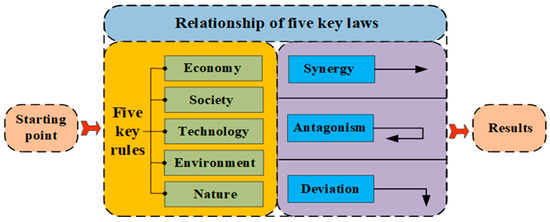
Figure 1.
The relationship of the five laws.
The development of things takes five laws to form a synergistic relationship, and in order to make the abstract theory concrete, a five-law coupling concept diagram is introduced here, as shown in Figure 2. Five circular areas located in the same plane in the diagram are labeled as the natural, social, economic, technological and environmental circles [27]. Each circle divides the plane into two areas, with the conforming area inside the circle and the violating area outside the circle. In Figure 2, marker 1 is the uniform action area, marker 2 is the two-law synergistic domain, marker 3 is the three-law synergistic domain, marker 4 is the four-law synergistic domain, and marker 5 is the five-law synergistic domain. The five-law synergistic domain is the region where sustainable development can be achieved, which is also the equilibrium state studied in this paper.
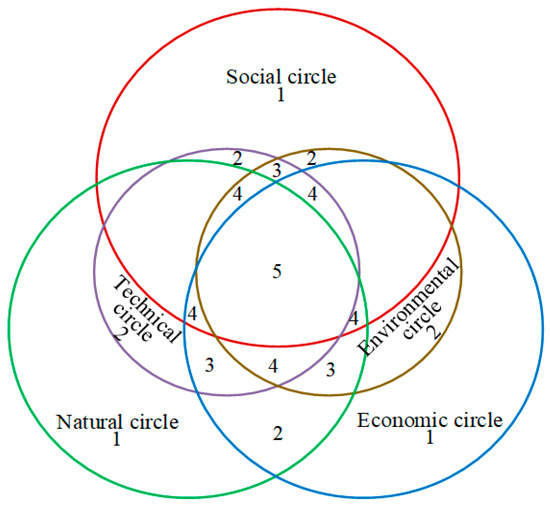
Figure 2.
Conceptual diagram of five-law coupling.
The synergy of five laws refers to the state of mutual adaptation and coordination among the economy, society, technology, nature, and the environment under the joint action of economic, social, technological, natural, and environmental laws. The five laws are closely related and constrain the evolution of human social civilization. In the state of the synergy of the five laws, each of the five systems plays a different role in human development: nature provides the material foundation, economy provides the driving force, society provides the organizational force, technology provides the support system, and the environment provides the constraint conditions so that the five laws work together to effectively drive human society forward.
3. Materials and Methods
3.1. Study Area
In this paper, Beijing is chosen as the object of empirical study. Beijing (39.4°–41.6° N, 115.7°–117.4° E) is the capital of China and the political, economic and cultural center of the country. However, in 2016, the Chinese Academy of Sciences published a study on China’s livable cities, which showed that after measuring the livability of 40 cities across the country, Beijing was found to be in the bottom first place with a livability index score of 56.24. Although Beijing has a steady level of economic development among the top cities in China, residents have a low recognition of the livability of Beijing [29]. Thus, it can be seen that economic development and eco-livable city construction are not simply in a positive relationship. In order to explore the relationship between economy, society, technology, environment, and nature and their synergy levels with urban eco-livability, and considering the availability of index data, this paper, therefore, selects Beijing, a representative city, as the research object to explore the feasible way to build an eco-livable city.
3.2. Study Methods
This paper focuses on the five-law synergy theory to study the ecological livability of Beijing, and the research process can be divided into four steps: (1) the construction of the index system; (2) the solution of the index weights; (3) the calculation of the evaluation value; and (4) the calculation of the coupling coordination degree. The actual process is shown in Figure 3.
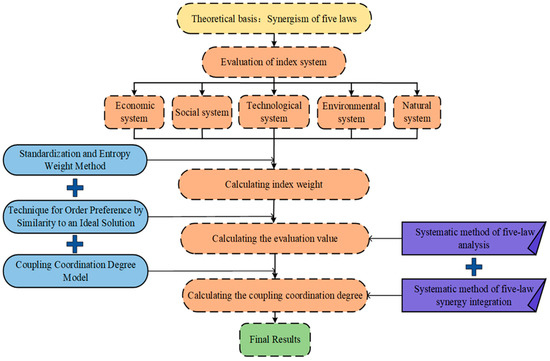
Figure 3.
Research design.
3.2.1. Index System Design
Experts and scholars mostly construct the evaluation index system of eco-livable cities based on their own perceptions, and no unified evaluation index system has been formed yet. However, a large amount of literature links the ecological livability of cities with the economy, society, and environment [30], and some scholars believe that natural climate and residents’ perceptions also have an impact on the ecological livability of cities [11], and with further research, experts and scholars begin to study urban issues from a synergistic perspective. Therefore, this study considers the development levels of the five systems of economy, society, technology, environment and nature and takes into account the synergistic relationship of the five systems to construct the multidimensional evaluation index system of urban ecological livability from the perspective of synergy of five laws. Most of the issues described with a composite index are complex problems, and complexity is reflected by the multidimensionality and multiscale representation of the issue [31]. The composite metric builder must not only make the most appropriate methodological choices at each step but also determine if they fit well together [32].
Based on the existing literature and the classification criteria and interpretation of indexes in the Beijing Statistical Yearbook, we believe that the level of development of the economic system can be described by economic efficiency, and therefore selected D1–D6 as the evaluation indexes. We are concerned that social equity has been a hot issue, so we divided the social system into two dimensions of social service and social equity and selected D7–D12 and D13–D14 as evaluation indexes, respectively. We use technological development to indicate technological systems and choose D15–D18 as evaluation indexes. We divide the evaluation indexes of the environmental system into two dimensions, pollutant treatment and environmental protection, considering the generated pollution and the prevention of pollution, and select D19–D22 and D23–D24 as the evaluation indexes. We use natural conditions to represent natural systems and select D25–D28 as evaluation indexes.
Evaluation indexes can be classified into positive, negative and neutral indexes according to their attributes, and the indexes involved in this study include positive and negative indexes. Positive indexes refer to the indexes whose evaluation value increases with the increase of indexes data, such as D1, D2, etc., and their attributes are indicated by “+”. The inverse indexes refer to the indexes whose evaluation value decreases as the indexes data increases, such as D9, D12, etc., and their properties are indicated by “−”. The selection of eco-livable city evaluation indexes follows the principles of scientificity, sensitivity and feasibility, and the following evaluation index system of an eco-livable city is finally formed, as shown in Table 1.

Table 1.
The index system of eco-livable cities is based on the Theory of Synergism of Five Laws.
3.2.2. Data Source
The empirical research part of this paper takes Beijing as an example. We have sorted out the development index data of Beijing from 2010 to 2021. The index data mainly come from Beijing Statistical Yearbook, which is the objective data publicly released by the government.
3.2.3. Data Standardization
By comparing various methods, this paper selects the linear proportional transformation method to standardize the index data, which can take into account the variability of the index data. Indexes can be divided into positive, negative and neutral indexes, and in the decision matrix, the standardization of indexes is performed as follows:
where rij is the score of the original index data after standardization; r’ij is the actual value of the index; r0 is the best value of the index.
3.2.4. Using Entropy Weighting Method to Determine Index Weight
The weighting process of the indexes can have a significant impact on the calculation results [45]. The entropy weighting method is a method to determine objective weights based on a judgment matrix [46]. When the evaluation object has a large difference in the value of a certain index, it means that the index provides more information and the weight of that index is larger [47]. The data in this paper come from the objective data published in the Beijing Statistical Yearbook, and the entropy weight method can fully tap the original index data to utilize the complete objective data information, which has stronger objectivity compared with the analytic hierarchy process method [48]. In addition, the entropy weight method is applicable to a variety of decision problems and different types of data.
When calculating the system weight, we take the weight of 28 indexes as 1 as the standard and then add the weights of those indexes included in each system to obtain the system weights. When calculating the coupling and coordination degree of the five systems, each system is taken as a whole; that is, the index weights in each system are added to 1, and this step is calculated by normalizing the index weights.
With m evaluation indexes and n evaluation objects, the original data matrix is , and the entropy of the i-th index is defined as:
where , , when , set . fij is the proportion of the j-th evaluation object in the i-th index; n is the number of evaluation objects; Hi is the entropy of the i-th index.
After defining the entropy of the i-th index, the entropy weight of the i-th index is defined as:
where 0 ≤ wi≤ 1, , and Hi is the entropy of the i-th index; m is the number of evaluation indexes; wi is the entropy weight of the i-th index.
3.2.5. Using the TOPSIS Method to Calculate Evaluation Value
TOPSIS (a technique for order preference by similarity to an ideal solution) is a model for evaluating systems with multiple scenarios and indexes for decision-making [49]. Compared to other methods, the TOPSIS model makes full use of information from the raw data, and its results accurately reflect the gaps between the evaluated scenarios:
where V+ denotes positive ideal value; V− denotes negative ideal value, i.e., the maximum and minimum values of the i-th index in the evaluation index in the j-th year.
Using the Euclidean distance formula to calculate the distance:
where Dj+ is the distance of the i-th index from yj+; Dj− is the distance of the i-th index from yj−; yij is the weighted standardization value of the i-th index in the j-th year.
where Cj is the closeness of the evaluation object to the positive ideal solution, i.e., the optimal solution.
3.2.6. Coupling Coordination Analysis of Five Systems
Coupling theory can be used to describe the degree of influence of interactions between two or more systems [50]. The currently commonly used coupling degree model specification formula is as follows:
where n is the number of systems; Ui is a system value, and its distribution interval is [0,1]; therefore, the coupling degree value C in [0,1], the larger the value of C, the smaller the discrete degree between systems, the higher the coupling degree.
The system comprehensive evaluation value T is calculated by the formula:
where Ui is the standardized value of the i-th system; ai is the weight of the i-th system.
The formula for the coordinated development degree D is:
The coupling degree [51] can reflect the association between systems, and the magnitude of its value reflects the strength of the connection between systems. More researchers have adopted the classification criteria of coordination level [52] and deduced the classification criteria of coordination development degree D (as in Table 2).

Table 2.
Classification criteria of coordination level and coordination development degree.
4. Results
4.1. The Contribution of Indexes at Each Level to the Ecological Livability of Beijing
The indexed weights were calculated according to Equations (1)–(5). The results of the calculation of indicator weights at each level are shown in Table 3. Index weights indicate the contribution of an index in the system and are used to calculate the combined evaluation value for each system individually, with the index weights for each system summing to 1. The system weights represent the contribution of the five systems in the evaluation of urban ecological livability, and the weights of the five systems are summed to 1. The system weights are used to calculate the comprehensive evaluation value of urban ecological livability and the coupling coordination degree of the five systems.

Table 3.
Index weights obtained from the entropy weighting method.
4.2. Trends in the Comprehensive Evaluation Value of the Five Systems
According to the calculations of Equations (6)–(10), we calculated the comprehensive evaluation values of each system of the eco-livable city and its overall values over the years (as shown in Figure 4). As a whole, the comprehensive evaluation value of the five systems has shown small fluctuations over the years (as shown in Table 4), and the entirety value has shown an increasing trend. In terms of the five systems, the evaluation values of the economic, social and technological systems generally show a linear growth trend. The evaluation value of environmental systems showed a stable upward trend from 2010 to 2016 and began to decline after reaching the peak in 2016, showing an overall trend of first rising and then falling. On the contrary, in 2014, the evaluation value of natural systems reached its lowest point in 12 years and showed a general trend of first decreasing and then increasing.
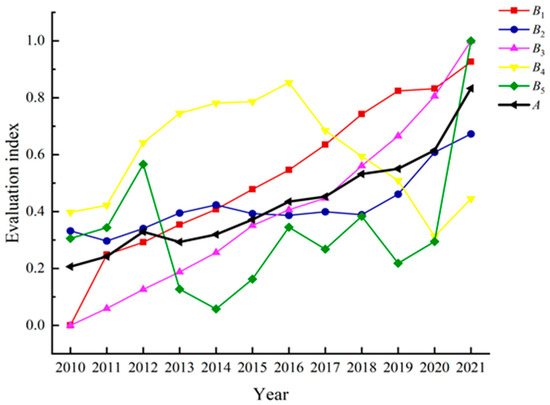
Figure 4.
Yearly trends of evaluation values of the five systems. B1—economic system; B2—social system; B3—technological system; B4—environmental system; B5—natural system; A—entirety.

Table 4.
Comprehensive evaluation value of each system overall over the years.
4.3. Trends in the Coupling Coordination of the Five Urban Systems
The coupling coordination degrees of the five systems in Beijing from 2010–2021 are calculated according to Equations (11)–(13) and classified according to the coupling level classification criteria in Table 2, and the results are shown in Table 5. The trend of the coupling coordinated degree of economic, social, technological, environmental and natural systems in Beijing from 2010–2021 is plotted according to the calculation results in Table 5. From Table 5 and Figure 5, the coupling degree and coordinated development degree of the five systems are evaluated by C-value and D-value, respectively. From the trend of the C-value, it can be seen that the coupling degree of the five systems in Beijing has great fluctuations. In 2010, the economic, social, technological, environmental and natural systems in Beijing were in an extremely uncoordinated state, indicating that the coupling mechanism of the five systems was weak. The coupling degree of the five systems increased significantly and then decreased slightly from 2011 to 2014. After 2014, the coupling degree of the five systems was basically stable and maintained at the well coordinated level and quality coordinated level, indicating that the coupling mechanism of the five systems is strong after 2014, i.e., there are strong internal links and interactions among the five systems.

Table 5.
Coupling level and coordinated development level of five systems.
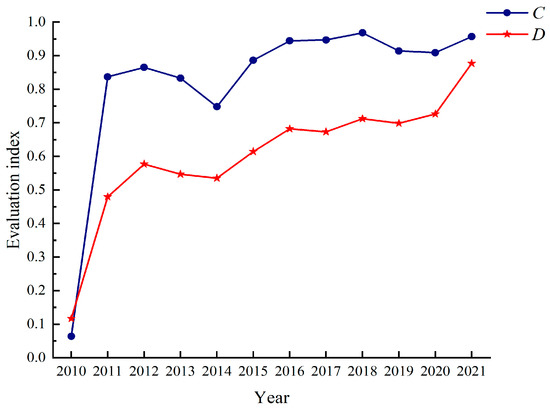
Figure 5.
Yearly trends of the level of coupling coordination for the five systems.
The level of coordinated development between systems is described quantitatively by the degree of coordinated development. From the trend of D-value, it can be seen that the degree of coordinated development among the five systems of economy, society, technology, environment and nature in Beijing shows a gradual increase during 2010–2021. The overall development process can be divided into three stages: the first stage is the initial development stage (2010), where the five systems in Beijing have a significantly unbalanced level of coordinated development and belong to the uncoordinated recession category; the second stage is the intermediate development stage (2011–2014), where the five systems are at the edge of coordination and discoordination and belong to the transitional development category; the third stage is the advanced development stage (2015–2021), the coordinated development degree exceeds 0.6, which belongs to the coordinated development category.
5. Discussions
5.1. Trend Analysis of Evaluation Values by the Systematic Method of Five-Law Analysis
5.1.1. Trend Analysis of the Evaluation Value of the Economic System
The level of development of the economic system in Beijing over the years has shown a roughly linear growth trend (as shown in Figure 6). In 2010, Beijing’s high-level economic development model was initially formed, and all indicators of Beijing’s economic system showed an upward trend, so the comprehensive evaluation value of Beijing’s economic system maintained a stable growth trend. As the economic development center of the country, Beijing is actively exploring the path of economic development [53], and Beijing has changed from a high-speed economic development model to a high-quality economic development model, which promotes the sustainable development of Beijing’s economy.
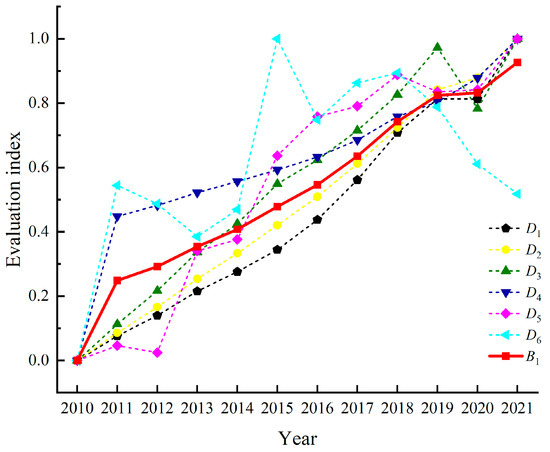
Figure 6.
The yearly trend of evaluation values of the economic system. D1—per capita GDP; D2—per capita disposable income; D3—per capita consumption; D4—social labor productivity; D5—per capita housing area; D6—proportion of tertiary industry; B1—economic system.
5.1.2. Trend Analysis of the Evaluation Value of the Social System
The level of development of Beijing’s social system has fluctuated considerably over the years. The urban registered unemployment rate (D9), Engel coefficient (D12), Gini coefficient (D13), and comparison of urban and rural consumption levels (D14) in the social system are negative indexes, and the negative indexes are positively processed and plotted in Figure 7. The development level of the social system in Beijing shows a slow upward trend. It is noteworthy that the assessed value of the social system in Beijing slightly decreased in 2014–2018, which may be related to the changes in the criminal case-solving rate and Gini coefficient. The decrease in the criminal case-solving rate will undermine social harmony and stability to a certain extent, while the increase in the Gini coefficient represents a more prominent social equity problem in Beijing, and the increase in social instability and the widening gap between the rich and the poor in society will reduce the residents’ satisfaction with the eco-livable city.

Figure 7.
Yearly trend of evaluation values of the social system. D7—average wage of employees; D8—number of hospital beds per 10,000 people; D9—urban registered unemployment rate; D10—number of schools; D11—criminal case solving rate; D12—Engel coefficient; D13—Gini coefficient; D14—comparison of urban and rural consumption levels; B2—social system.
5.1.3. Trend Analysis of the Evaluation Value of the Technological System
The development of Beijing’s technology system has been maintaining an upward trend, as seen in Figure 8. The number of patents granted (D16), the number of scientific researchers (D17), and the internal expenditure on R&D funds (D18) show a linear growth trend, but the number of students enrolled in general higher education institutions (D15) declined significantly after reaching a peak in 2014. As Beijing is the gathering place of key universities, and talents are the driving force of technology development, the shrinkage of the number of students enrolled in general universities is the main reason for the slowdown of technology system development (as shown in Figure 9). Beijing can maintain its innovation leadership through strategies such as encouraging companies to innovate in science and technology and changing organizational structures [54]. Beijing has taken the lead in establishing a three-way collaborative research system formed by universities, research institutes and innovative enterprises, which provides strong support for the practical promotion of development concepts and development strategies.
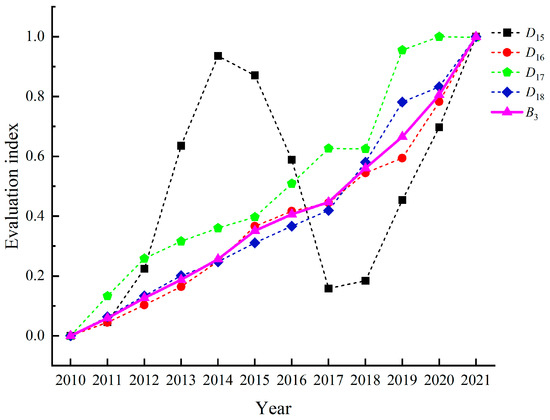
Figure 8.
Yearly trend of evaluation values of the technological system. D15—number of students enrolled in general higher education institutions; D16—number of patents granted; D17—number of scientific researchers; D18—internal expenditure on R&D funds; B3—technological system.

Figure 9.
Yearly trend of evaluation values of the environmental system. D19—urban greening coverage; D20—per capita public green space; D21—regional noise average; D22—sewage treatment rate D23—harmless disposal rate of domestic waste; D24—utilization rate of industrial solid waste; B4—environmental system.
5.1.4. Trend Analysis of the Evaluation Value of the Environmental System
As can be seen from Figure 9, the urban greening coverage (D19), per capita public green space (D20), sewage treatment rate (D22), and harmless disposal rate of domestic waste (D23) in Beijing show an increasing linear trend, however, the values of regional noise average(D21) and utilization rate of industrial solid waste(D24) have certain fluctuations. In 2016, the evaluation value of Beijing’s environmental system dropped significantly after reaching its peak, which was caused by a significant decrease in the evaluation value of the regional noise average (D21) and utilization rate of industrial solid waste (D24).
A review of relevant information shows that Beijing has defined the main tasks of environmental protection and pollution control, including reducing pollutant emissions from key projects and strengthening environmental monitoring of solid waste. Beijing was also one of the first regions to develop collaborative cross-area management of the atmosphere [55]. Since 2013, Beijing has been monitoring the concentration of PM2.5, and has been working to improve its environmental monitoring system and technologies for pollutant treatment.
5.1.5. Trend Analysis of the Evaluation Value of the Natural System
From Figure 10, it can be seen that the forest coverage (D25) and the area of nature reserves (D27) in Beijing generally show an increasing trend, while the per capita water resources (D26) and the excellent air quality rate (D28) drop significantly after reaching their peak in 2012, which is the main reason for the significant decrease in the trend of natural system development in Beijing. Beijing is short of water resources, and water conservation has become a strategic task to ensure the sustainable development of Beijing. Beijing should further strengthen its monitoring efforts and treatment of air pollutants to improve air quality.
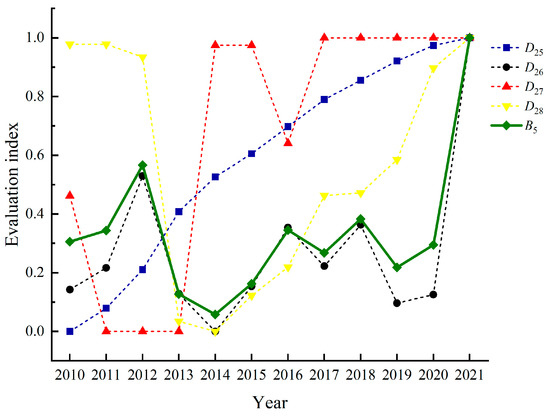
Figure 10.
Yearly trend of evaluation values of the natural system. D25—forest coverage; D26—per capita water resource; D27—area of nature reserve; D28—excellent air quality rate; B5—natural system.
5.2. Coupling Coordination Analysis by the Systematic Method of Five-Law Synergy Integration
From the calculation results of the comprehensive evaluation value of the five systems, the development status of the five systems over the past decade can be divided into four stages, the first stage being the technological system and the economic system lagging stage (2010), when the development level of the technological system and the economic system lags behind the other four systems, the second stage being the technological system lagging stage (2011–2012), the third stage being the natural system lagging stage (2013–2020), and the fourth stage being the environmental system lagging stage (2021).
From the calculation results of the coupling degree, the whole system has reached the quality coordinated level in 2021, indicating that the five systems in Beijing are closely connected and strongly influence each other. From the results of the coordination degree calculation, the coupling coordination degree of the whole system presents a gradually increasing trend, indicating that the five systems are developing simultaneously while maintaining close contact. The synergistic and stable development of the whole system is the result of the joint efforts of multiple subjects, and national policy is the main driving factor in this process. Figure 11 shows the diagram of the synergistic development of the five systems promoted by multiple subjects under the regulation of national policy.
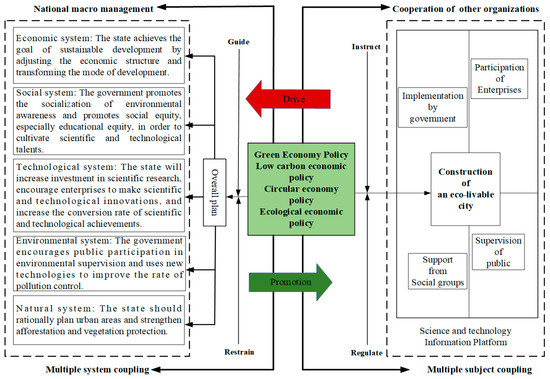
Figure 11.
The comprehensive model of policy-oriented coupling of multiple subjects to promote the coupling of five systems.
The government should actively implement national policies and consider the needs of marginalized people [56]; enterprises should actively respond to the national call for energy conservation, emission reduction, and green development and actively carry out transformation and upgrading [57]; social groups should play a positive influence role and support the work of the government; and the public should play a supervisory role over the work of the government, enterprises, and social groups to effectively promote the construction of ecologically livable cities. The implementation of these strategies will facilitate the development of the five systems to a quality coordinated level to achieve the goal of building a high-quality eco-livable city.
5.3. Limitations of the Study and Future Directions
- (1)
- The index system needs to be improved. In this paper, although the evaluation indexes of eco-livable cities are selected with reference to the existing research results, some of the evaluation indexes cannot be adopted due to the lack of data and other reasons, which may lead to bias in the evaluation results.
- (2)
- Based on the analysis of the coordination level of the five systems, this paper proposes to promote the synergy of the five systems through the synergy of multiple subjects, and the synergistic relationship between multiple subjects can be explored more deeply in the next research.
6. Conclusions
Building an eco-livable city is one of the effective ways to solve the “urban diseases” in urban construction and development, and it is also one of the mainstream directions for future urban development. To this end, this paper evaluates the ecological livability of Beijing based on the Theory of Synergism of Five Laws, using the entropy method and TOPSIS method, and analyzes the coupling and coordination of the five systems of eco-livable cities. The main conclusions of this paper are as follows.
Calculated by the multidimensional comprehensive evaluation model, the development level of economic and technological systems in Beijing shows a linear growth trend, while the development of social, environmental and natural systems shows different degrees of fluctuation. The results of the five-law analysis show that Beijing should pay attention to social equity issues and narrow the gap between the rich and the poor in the development of social systems. The development of the environmental system in Beijing is currently constrained by the utilization rate of industrial solid waste and regional noise average, and the development of the natural system is more influenced by the excellent air quality rate and per capita water resources.
Calculated by the coupling coordination model, the coupling coordination level of Beijing’s five systems of economy, society, technology, environment and nature has gone through three development stages, including the initial development stage (2010), the intermediate development stage (2011–2014), and the advanced development stage (2015–2021). Therefore, it can be seen that the five systems in Beijing are developing synchronously and showing a more coordinated trend, which means the overall ecological livability of Beijing shows an upward trend.
In terms of the development path of eco-livable cities, this paper proposes a comprehensive model of policy-oriented coupling of multiple subjects to drive the coupling of five systems. Multiple subjects need to play a synergistic role in driving the development of the five systems; the synergistic development of the five systems will, in turn, promote the coordination and unification of multiple subjects. This model provides new ideas for the government to formulate eco-livable city development strategies. Combining the calculation results with the model, the following eco-livable city development strategies are proposed in order to provide references for the construction of eco-livable cities.
- (1)
- The government should improve planning and policies for eco-livable cities. There is a relative lack of special planning and policies around eco-livable city construction in Beijing, and no comprehensive coordination department has been established. The government and the planning department should actively carry out special actions for the construction of eco-livable cities and introduce relevant laws and regulations to promote the construction of eco-livable cities towards the path of legalization.
- (2)
- The government should attach importance to the development of an urban ecological environment. An ecologically livable city should have an excellent ecological environment, such as good greenery, clean air and sufficient water. Air pollution, such as haze and water shortages, have become important factors affecting the eco-livability of Beijing. Therefore, the construction of an eco-livable city in Beijing should give priority to improving the ecological environment and making up for the shortcomings of ecological problems.
- (3)
- On the basis of clarifying the division of roles among the government, the market and the public in the construction of an eco-livable city, Beijing should continue to explore an operational mechanism of “government co-ordination, market operation and diversified participation” in urban construction. On the one hand, the government should guide market players to play an active role in capital investment, implementation, operation and maintenance and encourage social capital to participate in the construction of eco-livable cities; on the other hand, the construction of eco-livable cities should emphasize consultation with residents’ wishes and encourage their active participation.
Author Contributions
Conceptualization, C.F.; methodology, C.F. and H.Z.; software, H.Z.; validation, C.F. and H.Z.; formal analysis, H.Z.; investigation, C.F.; resources, C.F.; data curation, C.F. and H.Z.; writing—original draft preparation, C.F. and H.Z.; writing—review and editing, C.F. and H.Z.; visualization, C.F.; supervision, H.Z. All authors have read and agreed to the published version of the manuscript.
Funding
This research received no external funding.
Institutional Review Board Statement
Not applicable.
Informed Consent Statement
Not applicable.
Data Availability Statement
The data presented in this study are available on request from the corresponding author.
Conflicts of Interest
The authors declare no conflict of interest.
References
- Zhang, X.Q. The trends, promises and challenges of urbanisation in the world. Habitat Int. 2016, 54, 241–252. [Google Scholar] [CrossRef]
- Li, Z. Urbanization development model and Enlightenment in the world. China Econ. Trade Her. 2012, 2012, 42–44. [Google Scholar]
- Ma, D.M. Study on the Construction Path and Evaluation System of Eco-civilized City. Urban Dev. Stud. 2009, 16, 80–85. [Google Scholar]
- Fang, G.; Chen, X.M. Study on the Evaluation of Ecological Livable City in Anhui Based on Intuitionistic Fuzzy Theory. J. Chongqing Technol. Bus. Univ. 2018, 555, 012089. [Google Scholar]
- Li, H.; Cao, Y.; Zhang, S.H. Beijing-Tianjin-Hebei urban agglomeration of ecological livable appropriate industry coordinated development level measurement. Stat. Decis. 2021, 37, 78–81. [Google Scholar]
- Marans, R.W. Quality of urban life & environmental sustainability studies: Future linkage opportunities. Habitat Int. 2015, 45, 47–52. [Google Scholar]
- Martinez-Bravo, M.D.; Martinez-del-Rio, J.; Antolin-Lopez, R. Trade-offs among urban sustainability, pollution and livability in European cities. J. Clean. Prod. 2019, 224, 651–660. [Google Scholar] [CrossRef]
- Sites, W. Livable Cities? Urban Struggles for Livelihood and Sustainability; Social Service Review; The University of Chicago Press: Chicago, IL, USA, 2002. [Google Scholar]
- Mouratidis, K.; Yiannakou, A. What makes cities livable? Determinants of neighborhood satisfaction and neighborhood happiness in different contexts. Land Use Pol. 2021, 112, 105855. [Google Scholar] [CrossRef]
- Pacione, M. The Geography of Multiple Deprivation in the Clydeside Conurbation. Tijdschr. Voor Econ. En Soc. Geogr. 1995, 86, 407–425. [Google Scholar] [CrossRef]
- Saitluanga, B. Spatial Pattern of Urban Livability in Himalayan Region: A Case of Aizawl City, India. Soc. Indic. Res. 2014, 117, 541–559. [Google Scholar] [CrossRef]
- Liu, Q.F.; Song, J.P. Spatio-Temporal Evolution and Prediction Simulation of Urban Livable Level in Hunan Province. J. Nat. Sci. Hunan Norm. Univ. 2022, 45, 1–10. [Google Scholar]
- Bao, Q.Y.; Zeng, Y.; Qiu, X.F.; Shi, G.P.; Xu, Z.Y. Evaluation of climate livability in Zhejiang province based on GridMet Model. J. Meteorol. Sci. 2022, 42, 244–253. [Google Scholar]
- Reis, I.; Ferreira, F.; Meidutė-Kavaliauskienė, I.; Govindan, K.; Fang, W.; Falcão, P. An Evaluation Thermometer for Assessing City Sustainability and Livability. Sustain. Cities Soc. 2019, 47, 101449. [Google Scholar] [CrossRef]
- Zhang, Y.; Li, Q.Z.; Wang, H.Y.; Du, X.; Huang, H.P. Community scale livability evaluation integrating remote sensing, surface observation and geospatial big data. Int. J. Appl. Earth Obs. Geoinf. 2019, 80, 173–186. [Google Scholar] [CrossRef]
- Dong, X.Y.; Hu, Z.W.; Wu, J.J.; Wng, J.Z.; Yang, C.; Zhang, J.; Xia, J.Z.; Wu, G.F. Evaluation of ecological livability of dwelling area based on multi-source data: A case study of Shenzhen City. Acta Ecol. Sin. 2022, 42, 6607–6619. [Google Scholar]
- Ghasemi, K.; Hamzenejad, M.; Meshkini, A. The livability of Iranian and Islamic cities considering the nature of traditional land uses in the city and the rules of their settlement. Habitat Int. 2019, 90, 14. [Google Scholar] [CrossRef]
- Parker, J.; de Baro, M.E.Z. Green Infrastructure in the Urban Environment: A Systematic Quantitative Review. Sustainability 2019, 11, 3182. [Google Scholar] [CrossRef]
- Benites, A.J.; Simoes, A.F. Assessing the urban sustainable development strategy: An application of a smart city services sustainability taxonomy. Ecol. Indic. 2021, 127, 107734. [Google Scholar] [CrossRef]
- Wang, N.; Guo, J.L.; Zhang, J.; Fan, Y. Comparing eco-civilization theory and practice: Big-data evidence from China. J. Clean. Prod. 2022, 380, 10. [Google Scholar] [CrossRef]
- Lom, M.; Pribyl, O. Smart city model based on systems theory. Int. J. Inf. Manag. 2021, 56, 102092. [Google Scholar] [CrossRef]
- Ma, D.M. Re-discussing the status and role of NGOs in social crisis response based on the theory of synergy of five laws. Zhejiang Acad. J. 2009, 5, 188–192. [Google Scholar]
- Ding, Z.H. Study on Jiangsu Taihu Water Pollution Control Based upon the Principle of Five-Law Synergism. Ph.D. Thesis, Nanjing University, Nanjing, China, 2013. [Google Scholar]
- Bai, X.R. Study on Synergism of Five Laws and Developing Strategy of Xianlin New Urban Area in Nanjing. Ph.D. Thesis, Nanjing University, Nanjing, China, 2004. [Google Scholar]
- Zhao, W.M.; Zhou, X.H. Research on the Synergy Mechanism of five laws in Habitat Development. Urban Probl. 2007, 1, 20–23. [Google Scholar]
- Luo, T.Q. On the Laws of Technology. Ph.D. Thesis, Huazhong University of Science and Technology, Huazhong, China, 2012. [Google Scholar]
- Feng, L.; Zuo, Y.H. Sustainable Development and Synergism of Five Laws. China Popul. Resour. Environ. 2002, 6, 23–24. [Google Scholar]
- Cao, T.Y. Research on interactive development of China’s energy and financial structure based on coupling coordination degree model. Energy Rep. 2022, 8, 1743–1751. [Google Scholar] [CrossRef]
- Zhang, W.Z.; Yu, J.H. China Livable Cities Research Report; United Nations Development Programme (UNDP) China: Bejing, China, 2016; p. 279.
- Omuta, G.E.D. The quality of urban life and the perception of livability: A case study of neighbourhoods in Benin City, Nigeria. Soc. Indic. Res. 1988, 20, 417–440. [Google Scholar] [CrossRef]
- Nardo, M.; Saisana, M.; Saltelli, A.; Tarantola, S. Tools for Composite Indicators Building; Institute for the Protection and Security of the Citizen Econometrics and Statistical Support to Antifraud Unit: Ispra, Italy, 2005. [Google Scholar]
- OECD; JRC European Commission. Handbook on Constructing Composite Indicators: Methodology and User Guide; OECD: Paris, France, 2008. [Google Scholar]
- Xiao, Y.; Li, Y.; Tang, X.; Huang, H.; Wang, R. Assessing spatial-temporal evolution and key factors of urban livability in arid zone: The case study of the Loess Plateau, China. Ecol. Indic. 2022, 140, 108995. [Google Scholar] [CrossRef]
- Zhao, R.D.; Fang, C.L.; Liu, J.; Zhang, L.F. The evaluation and obstacle analysis of urban resilience from the multidimensional perspective in Chinese cities. Sustain. Cities Soc. 2022, 86, 104160. [Google Scholar] [CrossRef]
- Li, H.M.; Duan, P.S.; Guo, D.H. Evaluation of Regional Ecological Livable Degree and Its Influencing Factors: A Case Study of Xi’an. Ecol. Econ. 2019, 35, 80–85. [Google Scholar]
- Cui, H.; Fang, H.; Tian, Y.; Zheng, W.; Li, W.; Tian, W. Evaluation of Livability of Wuhan under Ecological Construction and Analysis of Its Spatial Pattern. Sustainability 2022, 14, 11283. [Google Scholar] [CrossRef]
- Wang, X.S.; Zhang, X.H.; Lei, Z. Tianjin Ecological Livable City Construction Index and Evaluation Research. China Popul. Resour. Environ. 2013, 23, 19–22. [Google Scholar]
- Cao, J.L.; Liu, C.C.; Xu, Y.G. Research on Construction Index and Evaluation of Ecological Livable City Based on PSR Model: Taking Xi’an City as an Example. Ecol. Econ. 2023, 39, 100–107. [Google Scholar]
- Cheng, H.; Chen, S.W. Development Evaluation and Factor Analysis on Scientific and Technological Innovation Eco-city. Sci. Technol. Manag. Res. 2013, 33, 32–36+41. [Google Scholar]
- Quan, S.L.; Liu, Y.J. Evaluation of Livability on China’s Major Cities. J. Shanxi Norm. Univ. (Nat. Sci. Ed.) 2010, 24, 112–116. [Google Scholar]
- Ma, G.; Li, X.; Zheng, J.P. Efficiency and equity in regional coal de-capacity allocation in China: A multiple objective programming model based on Gini coefficient and Data Envelopment Analysis. Resour. Policy 2020, 66, 101621. [Google Scholar] [CrossRef]
- Shi, G.Q.; Cao, J.; Tang, Z.Q.; Zhang, L.J. Research on Urban Ecological Livability Evaluation Based on Object Element Model: A case study of Zhangye. Contemp. Econ. 2018, 481, 71–75. [Google Scholar]
- Li, G.M.; Yang, Y.; Wu, Y.Y. Evaluation of Urban Ecological Livability in Yunnan Based on Set-pair Analysis. Environ. Sci. Manag. 2021, 46, 185–189. [Google Scholar] [CrossRef]
- Zhou, Y.Y. Study on the evaluation index system of livability of low carbon ecological city cluster. J. Hunan Univ. Technol. 2011, 16, 1–7. [Google Scholar]
- Becker, W.; Saisana, M.; Paruolo, P.; Vandecasteele, I. Weights and importance in composite indicators: Closing the gap. Ecol. Indic. 2017, 80, 12–22. [Google Scholar] [CrossRef]
- Li, Y.J.; Zhang, Q.; Wang, L.Z.; Liang, L. Regional environmental efficiency in China: An empirical analysis based on entropy weight method and non-parametric models. J. Clean. Prod. 2020, 276, 124147. [Google Scholar] [CrossRef]
- Cheng, W.J.; Xi, H.Y.; Sindikubwabo, C.; Si, J.H.; Zhao, C.G.; Yu, T.F.; Li, A.L.; Wu, T.R. Ecosystem health assessment of desert nature reserve with entropy weight and fuzzy mathematics methods: A case study of Badain Jaran Desert. Ecol. Indic. 2020, 119, 106843. [Google Scholar] [CrossRef]
- Correa Machado, A.M.; Ekel, P.I.; Libório, M.P. Goal-based participatory weighting scheme: Balancing objectivity and subjectivity in the construction of composite indicators. Qual. Quant. 2022, 1–21. [Google Scholar] [CrossRef]
- Fang, X.; Zou, J.Q.; Wu, Y.F.; Zhang, Y.F.; Zhao, Y.; Zhang, H.F. Evaluation of the sustainable development of an island ?Blue Economy?: A case study of Hainan, China. Sustain. Cities Soc. 2021, 66, 102662. [Google Scholar] [CrossRef]
- Yang, C.; Zhao, S.Q. Urban vertical profiles of three most urbanized Chinese cities and the spatial coupling with horizontal urban expansion. Land Use Pol. 2022, 113, 105919. [Google Scholar] [CrossRef]
- Chen, P.; Shi, X.Q. Dynamic evaluation of China’s ecological civilization construction based on target correlation degree and coupling coordination degree. Environ. Impact Assess. Rev. 2022, 93, 106734. [Google Scholar] [CrossRef]
- Liao, Z.B. Quantitative evaluation and classification System of Coordinated development of environment and economy: A case study of Pearl River Delta Urban Agglomeration. Trop. Geogr. 1999, 2, 76–82. [Google Scholar]
- Wu, D.S.; Ning, S. Dynamic assessment of urban economy-environment-energy system using system dynamics model: A case study in Beijing. Environ. Res. 2018, 164, 70–84. [Google Scholar] [CrossRef]
- Conceicao, P.; Hamill, D.; Pinheiro, P. Innovative science and technology commercialization strategies at 3M: A case study. J. Eng. Technol. Manag. 2002, 19, 25–38. [Google Scholar] [CrossRef]
- Wei, N.; Meng, Q.G. Mechanism and Institutional Logic of Cross-regional Collaborative Governance of Air Pollution-Based on the Cooperative Practice of Jing-Jin-Ji Region. China Soft Sci. 2018, 10, 79–92. [Google Scholar]
- Levenda, A.M.; Keough, N.; Rock, M.; Miller, B. Rethinking public participation in the smart city. Can. Geogr.-Geogr. Can. 2020, 64, 344–358. [Google Scholar] [CrossRef]
- Zhang, X.H.; Dong, L.B.; Huang, Y.L.; Xu, Y.L.; Qin, H.Y.; Qiao, Z.H. Equilibrium Relationship between Ecosystem Service Supply and Consumption Driven by Economic Development and Ecological Restoration. Sustainability 2021, 13, 1486. [Google Scholar] [CrossRef]
Disclaimer/Publisher’s Note: The statements, opinions and data contained in all publications are solely those of the individual author(s) and contributor(s) and not of MDPI and/or the editor(s). MDPI and/or the editor(s) disclaim responsibility for any injury to people or property resulting from any ideas, methods, instructions or products referred to in the content. |
© 2023 by the authors. Licensee MDPI, Basel, Switzerland. This article is an open access article distributed under the terms and conditions of the Creative Commons Attribution (CC BY) license (https://creativecommons.org/licenses/by/4.0/).